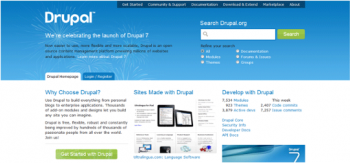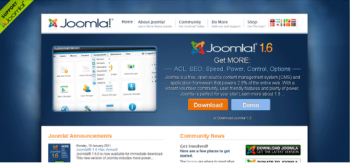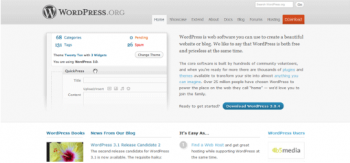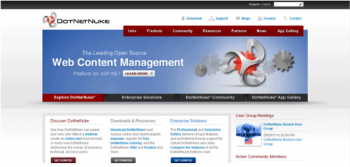Nowadays every new and popular website that we know of is implemented using a content management system(CMS). There is so much that can be achieved with a website using a CMS. Thus, the reason for choosing a particular one from the market for your own website depends on the tasks you want to accomplish with it. Generally speaking, some of the CMS’s are popularly known for particular tasks they can accomplish like for blogs, using WordPress makes sense, for large scale websites Drupal CMS is deemed a better fit, while Joomla CMS is easier to learn for newbies. .NET developers prefer alternative DotNetNuke or umbraco CMS. Besides these there are other CMS that are coming up in the market, CMS Made Simple and Liferay are amongst the most popular CMS based on the number of downloads and there are others like Elgg and MODx that are the rising stars.
Let us compare the features and benefits of using these content management systems:
Top Four Content Management Systems
#1. Drupal
 1% of all the websites over the internet are based on this platform. It is estimated that about 7.2 million sites were powered by Drupal as of july 2010. Drupal started out in 2001. In one year from May 2007 to April 2008, Drupal was downloaded from their official site for 1.4 million times, an increase of about 125% from the previous year. It is now ranked as #3 after Joomla and ranks before DotNetNuke).
1% of all the websites over the internet are based on this platform. It is estimated that about 7.2 million sites were powered by Drupal as of july 2010. Drupal started out in 2001. In one year from May 2007 to April 2008, Drupal was downloaded from their official site for 1.4 million times, an increase of about 125% from the previous year. It is now ranked as #3 after Joomla and ranks before DotNetNuke).
Weekly downloads: 33,671
Major Features:
- Drupal lets you handle multiple sites in multiple languages. You can use it for blogging, as a corporate site, gallery, and many other types you can think of.
- It let’s you manage your site’s users, providing standard registration, including OpenID support. You can set various access control rules for your site to limit the activity of your site’s users.
- Provides other facilities like multiple-level menu system, advanced search, template customizations and RSS feed aggregator.
- Drupal CMS also supports Database management systems like MySQL, PostgreSQL, MariaDB, and SQLite.
- Provides search engine friendly descriptive URLs.
- To increase its performance, you can use caching. It also provides good security features with notifications about the new update releases.
- It is powered by jQuery JavaScript Framework.
- Almost 7000 free community-contributed add-ons or plugins are available, known as contrib modules.
#2. Joomla

Joomla was the result of the fork of Mambo CMS on August 17,2005. Within its first year of release it was downloaded for more than 2.5 million times. Ranked as #2 after WordPress and before Drupal, Joomla platform has been utilized by world’s 2.5% websites over the internet.
Weekly Downloads: 113,836
Major Features:
- Same as Drupal, you can manage multiple sites with Joomla as well in multiple languages. It can be used for blogging, corporate sites, gallery and other purposes.
- You can easily control the access features of your site, what your visitors or users can see or use on your site.
- It also provides multiple level menu and content category systems, template customizations, advanced search features and RSS feed aggregator.
- It officially supports MySQL.
- Page caching technique for increased performance.
- Provides moderate descriptive URLs, which is still not fully customizable as you can do with WordPress.
- It is powered by MooTools JavaScript framework.
- It offers 6000 plugin options that are free and paid both.
#3. WordPress

WordPress first came into being on May 27,2003 by Matt Mullenweg as a fork of b2/cafelog. As of August 2010, version 3.0 had been downloaded massively 12.5 million times. Nowadays, it is known as the #1 ranked CMS and is very popular for blogging platform.
Weekly downloads: 983,625
Major Features:
- As said before it is highly customizable and preferable platform for blogging.
- Easy to switch themes.
- Users can re-arrange widgets without editing PHP or HTML code.
- Official support for only MySQL.
- It lets you customize your URL to make it search engine friendly, clean permalink structure and excellent for SEO.
- Nested and multiple categories to articles.
- Advanced search by tags.
- Highly interactive and intuitive UI
- jQuery JavaScript framework.
- Supports the trackback and pingback features for displaying links to other sites that have themselves been linked to some post or article.
- Rich plugin features that can be used as a part of the base install and helps users and developers to extend its functionality. Supports 12,780 plugins and 1,315 themes.
#4. DotNetNuke

DotnetNuke is the most widely used platform as said before by .NET developers and is based on Microsoft’s .NET technology. It is an open source platform for building websites. It comes under two licenses: one is community Edition BSD-style license and a commercial proprietary license. The community proprietary license is a popular web content management system and application development framework for ASP.NET and has been downloaded over 6 million times and 600,000 production websites until october 2010. It has been ranked as #4 after Drupal and before Liferay.
Weekly Downloads: 13,000
Major Features:
- It can distinguish between community(common features) and enterprise level edition(full set of features).
- Various modules and data providers.
- It supports language packs of about 60 languages.
- Customizable through skins and templates.
